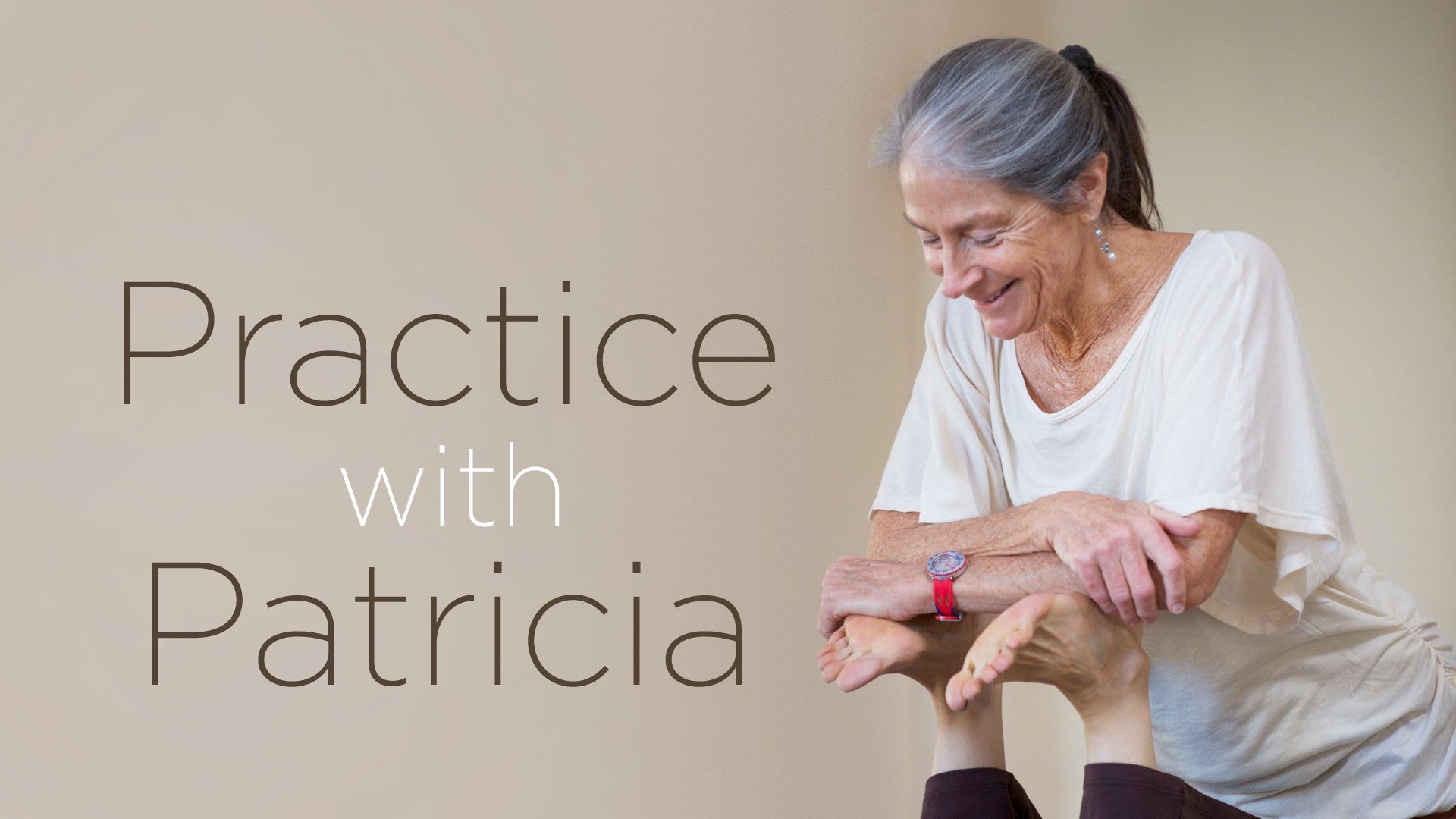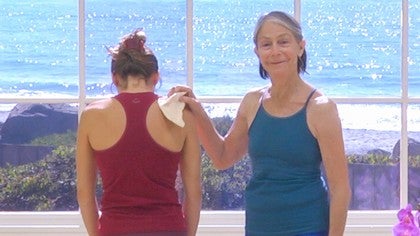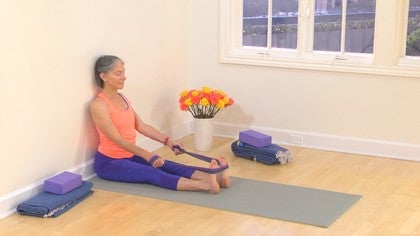Description
About This Video
Transcript
Read Full Transcript
So we're going to work with a bone today that you can learn a lot about your upper back and how you stay upright. This is the scapula shoulder blade, what we know is the shoulder blade, and I have Alana here with me who's going to help help us to see this because we need to see her we need to see a back and the the way the movements of the shoulder blade and so on we'll see both with this bone and then we'll also see as Alana does it with her body and then I'll bring you into at some point how to find your own and feel it a little bit in your own body and we'll do some exercises some some openings and strengthenings. So here's a close-up of the shoulder blade and you can see it's a pretty pretty big bone this is just about life size it might be a little smaller or bigger depending on the body size and it's it's got this these very interesting wings almost like a victory sign out to the side and then as I turn it around you can see how thin it is very wide very rather thin and then there's the victory sign and facing you now I've got the light just lovely coming on to this part of there you can see a semi circular pattern right here and that's actually a little bit of a it's a little bit of a cup this semi circular part here and that into that cup comes your arm bone your arm bone sits into that and part of the shoulder blade anatomy is that the the back of the shoulder blade all the way over here attaches to the arm and then the third piece is voila the collarbone which comes all the way to the center of the sternum so it's it's quite mechanically fascinating and the movements of the shoulder blade it can rotate and when it rotates because the arm is connected to it right here put this over here because the arm is connected to it right there as it rotates the arm moves up and down okay and then it can it can also tip forward and back and I will show these movements with the scapula on Alana's back and then we'll play a little bit with feeling it ourselves and doing some things along with Alana so here we go now Alana will turn around and face the beautiful ocean and we can see her her back she's got this nice racer back and so the shoulder blades are here and I'm gonna just palpate with my hands we have the top where the collarbone connects and the shoulder blade the top part of the shoulder blade the the wide part here and then it comes down can feel it here here and then there's the bottom tip right now so if I were to put this bone over her bone you would see that it's about like that and there's the place where the arm bone would fit in okay so if she raises this arm up slowly to just horizontal it's going to be tipping about that much and and now as I touch here that's where the tip of her shoulder blade is so it hasn't rotated a huge amount but it has now to make it easier for her to take her arm overhead she's gonna rotate so that her palm faces up you can see that the shoulder turned back and then she's gonna slowly take her arm overhead and I'm touching the tip here with my thumb of her shoulder blade and you can see that the shoulder blade moves that much that's it that's a huge amount of change and and these other parts are there in order to for muscles to attach to them so that's that's how the shoulder blade stays on okay now slowly bring your arm down again and the shoulder blade is turning with her and all the way down and then now we see it standing as it would when we're standing upright the the the line here is almost parallel to her spine if she now draws her shoulder blades together it actually becomes even more parallel there's the tip and there's the top so almost parallel and how close they are you can you can maybe not see but there's that's how close the shoulder blades are together and now she's gonna try she's gonna scrunch the top shoulder blades together and that's more of an action like this and and it does tend to raise the shoulders although I wonder if you can bring them down a little and still yeah so when I'm when I suggest to people to bring their shoulder blades together I'm more interested in in what we can do with getting the lower tips coming together so let's not squeeze from the top and stay a little bit broader across here and then draw the middle and lower shoulder blades together I mean it's okay if the tops comes a little okay so now I'm gonna put the bone down and I'm gonna just suggest that Alana can and you can join us in this part so Alana's gonna raise her left arm up just about to 90 degrees with the elbow bent and and then she's gonna reach across with her right arm and reach under to see if she can can touch with her hand all the way to where the shoulder blade bone is and if you can't one thing that you can do is you can wrap your arm more around to the front of your body is it starting to come if you come a little higher you can feel the bone yeah so there's the bone and and she's and it's way wide now because she's brought her arm around the bone is way out like this okay so then now start to take that arm up and as you're doing this also you're doing this you can feel the movement that comes from there and then she's gonna start to bring her arm down elbow bent at first and then as she stretches her arm down and brings it out she may not be able to feel it anymore because it's not wrapping around the body so much okay so let's do the other arm bring your left arm across across to this one and see if you can reach over the top of your arm and see now she can she can touch the top edge of the shoulder blade and then she's gonna and and hopefully you can too and then she's gonna turn the palm up so you can do that because that helps to make it easier to raise the arm overhead and with her fingers and slowly come up the rest of the way perhaps with your fingers you can feel some of the rotation of the shoulder blade as the arm comes up and then down again as the arm comes down okay and you can do that a second time just sweep the arm up see if you can feel the bone moving under your hand under your fingers and now pause here with the arm overhead and I'm gonna suggest to Alana that she release her left hand and wrap around under here and you can poke around and then try to follow the line of the shoulder blade down to the side of your rib cage if you're poking a little bit you can probably start to find where is the bottom tip of the shoulder blade and it's way out to the side come down a little further and I think the tip of the bone is right there so it's really almost completely to the side of the shoulder blade whereas before it was it was way over here so a lot of mobility and that's what allows the arm to move okay now bring your arm down again and we saw what happened when when she brought her shoulder blades closer together yeah now what I want Alana to do is to kind of round forward so you're gonna do that yeah and what the shoulder blade does is it climbs upward and it kind of comes off the back so let's have you turn a little bit of an angle maybe 45 degrees and stand upright again so there's the bottom tip of the shoulder blade and it's it's it's congruent with the back it's like resting on the rib cage now she's gonna slump forward and as she does that it it kind of pops up now bring your head upright and look straight ahead and you can see and then turn to a 90 degree angle she doesn't like it stay in the slump and then lift your head upright and look so in order for her to look straight ahead when her shoulders are in this position she has to kind of she has to kind of poke forward from the neck to get there whereas when she's standing upright and let your chin stay level the neck has more of a natural curve so the shoulder blades are kind of prisoner to our to our posture they can't support our heart they can't support our chest if we decide to to be slumpy and we might not even have made a conscious decision most of our internal decisions you may have noticed we're not conscious so what we're going to work with then are a few pieces that we can start to bring the back body into consciousness how to help us stay upright here we go you've felt your your shoulder blade a bit and now we'll see if you can tune into just feeling it by some some very conscious movements so I'm gonna have Alana right here and I put this down for now she's gonna do some rounding forward and reach her arms around to try to touch maybe the outside edge of her shoulder blade and then and this is really a delicious thing to do because it stretches all the tissues between here that get so tired from holding us up from having our head forward so when we're having our head forward all the time it's not just the neck that gets tired it's the upper back and all the way even down to the lower back so you this stretches those tissues and then she's gonna open her arms out kind of like she's saying oh wow and she's letting her elbows go in front and her hands slightly behind so what this is happening here is that she's rotating her upper arm bone in in the scapula and that helps the scapula come down onto her back okay and then go back forward again these things are nice to repeat because and did you switch your arms and yeah she knows to switch so at one point she had her left arm on top and then she comes around and has a right arm on top that sort of thing and then she's gonna lift up again and she's letting the arms move the shoulder blades you can feel your back working now and this is so interesting because if you turn the palm like this it sort of reflects what the shoulder blade is doing here go ahead and let your head come up again like you were a moment ago the shoulder heart can in the chest is just resting on this hand resting on the shoulder blades that's the altar okay now she's gonna turn and face the wall the the the ocean and she'll do those movements again so she's gonna wrap around and you can see the rounding of the spine and she's releasing her neck that's so beautiful because the neck and the upper back it's so tired and then she's gonna open out one more time she keeps the elbows bent she keeps them coming in front of the shoulders a little bit and the hands supporting the imitating what the shoulder blades are doing okay and then you can let your arms come down and just tune into how that feels and then the next movement that we're gonna do which is so helpful for evening so I can see that Alana's a little thicker and more developed over here than she is over here and I know that she's left-handed and we are often thicker and more developed on her right side so usually that means that the shoulder blade isn't carried on the back in the same way so all these things are also working towards helping us to carry our shoulder blades so that our shoulder blades can carry help help us be upright so here you go you're gonna bring your hands up interlace them behind your skull and depending on your flexibility you you may not be able to bring the elbows back as far as Alana is but you can see and I can touch her shoulder blades again here and here that both shoulder blade tips have gone way out to the side and her back is fairly flat and it just helps to even the the working of the shoulder blades so what I want you to do now is to turn towards me and sometimes what I have students do in this position is I'll have them either kneeling on the floor sitting on a chair with a block between the knees and then I'll have them just turn the upper body so turn the upper body towards our friends here that are watching us uh-huh and and I'm holding her pelvis but if she can learn to hold her pelvis and not turn her pelvis this is strengthening the back and helping the shoulder blades to work more evenly and now she's gonna come back and face me and then as she turns to face the ocean she's having to struggle a little more on this side that's interesting as she turns to her left her pelvis wants to turn to the left so how much can you turn the pelvis back towards me and keep that activity good so let's have you try this yourself with your arms overhead so now come back to face me Alana and as you turn your torso but not your hips to face our friends here you notice the work involved and then come back to the center and you're following Alana on this if you like and then as you go around turning to the opposite side you're going to resist turning from the pelvis and you can feel both that you're working parts of the belly and the pelvis and that you're working the upper back and then come and face me again and just open the elbows back and just enjoy that beautiful good and then you can let your arms come down good now we're going to have one shoulder blade and the we're going to have the the most opposite movements that the yogis developed some time back of the shoulder blade so Alana will face the ocean and I'm going to get the strap out in case she needs it do your easier side first so yeah so because she's left handed she can she can bring that left arm up and again the shoulder blade tip is way out to the side here and what that tells us is that her shoulder blade has as she's taken her arm overhead instead of being like this it's rotated to allow for the arm to come up otherwise how could the arm come up if the shoulder blade doesn't and we've got a big hollow here which happens for most people in in the in this activity because the shoulder blade has to rotate so far so far this way and it's not the easiest direction for the shoulder blade to move now I'm going to ask Alana to turn towards me and you can see and this would probably happen with you too the arm has gone into this rotation in that direction which is so different and now turn to face them from what this arm is doing okay so this is what it looks like from the front it's called Gomukhasana and then to make it to add the final challenge Alana is going to stand more on her heels and she's going to bring her lower ribs back a little bit yeah and she's gonna try to breathe very good okay let your arms come down and then let's have you face the ocean again thank you now she's gonna bring a right arm up we have to do both sides and I think you'll notice that it's a little tougher for her to get there she was able to actually cross fingers and here they're sort of just barely touching and if she moves her ribs back and keep moving the ribs back and actually let your arms come a little bit more like bend from your ribs a little there that's a truer spine so it's really challenging and for some people this hand may be way way down you don't want to wrench your shoulder blade trying to get to anywhere so I'm gonna unwind this strap and I'm gonna give this to her which you could have done that before you brought your arm over and when you try it on your own you can do that and and then she reaches for the strap which might be go way down might be way down here is where she can reach it I better pull that strap well let me pull it down there so as she takes a hold of that this hand the low hand can tug a little to get this arm to move and conversely this hand can tug up just a little to help this one move and don't be too ambitious to make great strides in this because the shoulder joint needs to have stability and not be overstretched so we move into these very unusual stretches with just a little bit of tenderness and care and noticing what hurts and not going beyond that okay you can show them how you would release this you would hold on to the strap with the upper hand and then bring the arm down great you can give me that okay all right so we've already done the one with the hands behind the head so the next one and I think I will have you do it facing me is the standing arm circles she's gonna bring her hands just about and you can do this with us about 45 degrees up and you're gonna make a fist with the hand with the thumbs facing forward and it's a very firm fist so that you're not bending at the wrist and you're not bending at the elbow we want to bring all the work into the shoulders and the back here before she raises her arms she's gonna squeeze her shoulder blades together without taking the arms back so sometimes when we squeeze our shoulder blades together we take the arms back so we're not gonna do that and then she's gonna come up a little higher so that she's shoulder height and you can do anywhere between 10 and 40 circles and these circles are kind of quick uh-huh and about five to six inches in diameter yeah and you can see the movement of the body she's actually helping train her lower back to step to steady here with these these movements okay and then when you're done you can let your arms come down rest you can feel the work can't you yeah so now she'll make the fist and turn her thumbs back and before she gets very high she's gonna squeeze her shoulder blades together yes and then come a little higher people tend to have a slightly harder time to do this one I want you to face now so they can see the arm position from the front because what I'm noticing is her strong side has a little more trouble straightening the elbow here so I'm gonna ask her to keep both arms just a little lower on this but elbows really straight and when the thumbs are pointing back and the shoulder blades are coming together you're gonna be making the circles backwards so she can make anywhere between 10 slightly bigger and fairly rapid although when you first start doing this maybe slower is okay and maybe only doing 10 15 20 it doesn't take very long to be able to do 40 or 50 of these good okay and then you can let your arms come down so she can she can definitely feel that you can be quite well developed and and not have this strength in the shoulder blade region so that's one reason why I like these poses so much and then there's one more it looks similar but this time you're gonna have your hands nice and open I'll get behind you a little bit and you're gonna open them up to shoulder height again and you're gonna imagine if you have a wall at home that you could place yourself against so that you could you would be able to feel your your your hips and buttock and shoulders so if your shoulders were at the wall you'd be a little further back and your hips would be a little further forward there you go you would and don't force your head to come back if it comes back easily fine but if you have to lift the chin to take your head back don't do it and then she's gonna just side bend from the waist so you can come to it towards your left a little bit first so just happening here in the waist in the rib cage and then she's gonna lift up and go over to the other side okay now pause I don't want you to move your arms so just don't move your waist right now so when you're doing this you won't be doing anything like this with the arms the arms always stay like so so now she's gonna go over to the right and she won't raise the right hand any faster than her torso makes it happen so bring it down just a little bit yeah so that relationship stays the same and then she's gonna come up again so two more times one one time to your left one time to your right and if you have a wall it's really great to do this at a wall and anytime you try any new things like this really pay attention to how it feels is something aching hurting maybe do it to a lesser degree don't go as deep into it if that doesn't help then maybe it's just not the thing for you to be doing right now so one more time to your right and then back to your center and you can let the arms come down for a moment and you're gonna then separate your feet so they're maybe 18 to 20 inches apart yeah maybe a teeny bit more yeah and make sure that you're not standing with your with your feet turned out you always want to have the feet parallel to each other because it affects the way the thighs come into the hip socket and then she's gonna raise her arms up to 90 degrees even if you're not neat internally rotated thighs make the feet while you're doing this parallel to each other because if you're especially if you're at the wall and you're doing these side bends it's going to help to start to help to move the femur a little bit okay so she's going to do three to each side no that's it okay don't raise the arm that's it and then over to the side yeah good and then over to the other side that's it if you were at the wall you would be feeling your fingertips the backs of your arms the shoulder blades gliding along the surface of the wall and so you don't want to do it against a brick wall or anything you know nice indoor wall if you don't have a wall try it without but the the equalizing factor of having the wall is priceless really take that Rembrandt off the wall for a couple minutes and then put it back up so she's on her third to the left she'll do one more to the right good and then back to center good and then let the arms come down and then you could do another set with the feet even wider but I think we'll go to back to the feet back to the original position which is the width of the hips apart and she'll do three more you can move slightly faster if you like but it's good not to be in a hurry so she's really attending to all the details of keeping her back straight and not going too far and not moving the arms and that's more important way more important than speed and just notice what you notice in this you can feel some pulling and stretching in here one side of the spine is getting long one side is compressing and getting short and so it's kind of I think of it kind of like a cat you know massaging stretching massaging stretching and it develops the musculature of the lower back as well as the upper back but it also stretches so you get a longer resting length easier for blood and circulation to come in there once you're back up to shoulder height you can let your arms come down again so she's noticing that this is work and and actually if you can work up to five to each side after a couple of weeks and it'll be easy but maybe not at first maybe two to each side is what you want to do at first and I hadn't thought of a Sanskrit name for this but my friend Richard Rosen who's been doing a lot of exploration into Sanskrit and ancient yoga practices he's authored this book called the original yoga which is just tremendous he found a name for this and it's kulala chakrasana so chakra right the energy centers in the body it means wheel there's this wheel like action that she's doing and kulala means potters so potters wheel now we did we just do we did we just do this one I'm sorry potters wheel is this one potters wheel is this one when I went to India 1980 the way they got their potters wheel going is they stuck they stuck a stick until the outside edge of the wheel say the wheel was this big and they would turn it with a stick so there are the arms turning the cosmic potters wheel okay so now do I just want you to remember this when you say oh wow you don't say it like this you say oh wow like this and then namaste thank you Alana and thank you have fun with this
Practice with Patricia
Comments
You need to be a subscriber to post a comment.
Please Log In or Create an Account to start your free trial.















